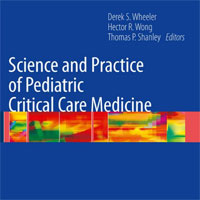Tag: pediatrics
AKI Defined by Fluid-Corrected Creatinine in Premature Neonates
In this secondary analysis of the multicenter PENUT trial, we describe fluid-corrected acute kidney injury (AKI) and evaluate associations with short-term and long-term outcomes in premature neonates with fluid-corrected... read more
Outcomes and Characteristics of Cardiac Arrest in Children with Pulmonary Hypertension
In this prospective study of children who received CPR in intensive care units, a pre-existing diagnosis pulmonary hypertension was present in 16% of children but was not associated with statistically significant differences... read more
Multiple Electrolytes Solution vs. Saline as Bolus Fluid for Pediatric Septic Shock Resuscitation
Among children presenting with septic shock, fluid resuscitation with MES (balanced crystalloid) as compared with 0.9% saline resulted in a significantly lower incidence of new and/or progressive AKI during the first 7 days... read more
Oxygen Support Needs in Children with RSV vs. COVID-19
Children with respiratory syncytial virus (RSV) had a higher risk of pneumonia, bronchiolitis, and a hospital stay of more than 4 days vs children with COVID-19 or influenza. Investigators compared demographic and clinical... read more
Multifaceted Early Mobility Intervention Impact for Critically Ill Children
This study will examine whether a multifaceted strategy to optimize early mobility affects the duration of mechanical ventilation, delirium incidence, and functional outcomes in critically ill children. This study will... read more
Heparin-based vs. Bivalirudin-based Anticoagulation in Pediatric ECMO
Bivalirudin may be a safe, cost-effective alternative to heparin in achieving anticoagulation in pediatric extracorporeal membrane oxygenation (ECMO) patients. Prospective multicenter studies and randomized control trials... read more
Sick Children Identification in Acute Care Settings
At the heart of every pediatric consultation is the clinician’s responsibility to determine ‘is this child sick?’ In pediatrics illustrative language communicates a clinical picture of the child before us. When... read more
Heterogeneity in Pediatric ARDS: Challenges and Complexities in Diagnosis and Treatment
Pediatric intensive care physicians are well-acquainted with the concept of heterogeneity, as the patients, pathologies, and treatments they encounter can vary greatly both within the pediatric intensive care unit and within... read more
Pronation Improves Respiratory Outcomes in Neonates with Respiratory Failure
This study found that 6-hour periods of pronation (lying on the stomach) can improve gas exchange and lung function in neonates (newborn infants) with three types of respiratory failure, without causing any negative effects... read more
The developing kidney: Perinatal aspects and relevance throughout life
Human perinatal nephrology is a very diverse field in medicine, shared—among others—between obstetricians, neonatologists and nephrologists. Extremely low birth weight infants, babies with growth restriction, and specific... read more
Surfactant Therapies for Pediatric ARDS
We advocate for well-designed preclinical and explanatory clinical studies to investigate the use of surfactant for pediatric (PARDS) and neonatal (NARDS) acute respiratory distress syndrome. Given the accumulating knowledge... read more
Pulmonary Aeration and Posterior Collapse Assessed by Electrical Impedance Tomography in Healthy Children
The aim of this study was to evaluate the changes in the lung aeration estimated by electrical impedance tomography as the end-expiratory lung impedance after anesthesia induction in pediatric patients. This was a prospective,... read more
Sepsis-Associated AKI Risks in the PICU
In children with severe sepsis, the degree of hemodynamic support as measured by the VIS and the presence of fluid overload may identify patients at increased risk of developing severe acute kidney injury (AKI). Children... read more
Nasotracheal Intubation on Postoperative Neonates with Congenital Heart Disease
Nasotracheal intubation (NTI) is feasible and safe in neonatal cardiac surgery. System-level engagement with stakeholders is necessary to change clinical practice. NTI facilitates early SLP evaluation and treatment and significantly... read more
Trends in Time to Extubation for Pediatric Postoperative Cardiac Patients
In this large, multicenter database study, early extubation rates in postoperative cardiac patients did not significantly change between 2009 and 2018. Centers that performed early extubation more frequently did not have... read more
Machine Learning Model Validation for Prediction of Potential PICU Transfer
We developed and externally validated a novel machine learning model that identifies ICU transfers in hospitalized children more accurately than current tools. Our model enables early detection of children at risk for... read more
Prevalence of PICS in Mechanically Ventilated Patients with COVID-19
Coronavirus disease 19 (COVID-19) patients usually require long periods of mechanical ventilation and sedation, which added to steroid therapy, favours a predisposition to the development of delirium and subsequent mental... read more
The Mysterious Vanishing of MIS-C
Whilst the overwhelming majority of Covid-19 infections in healthy children are mild or asymptomatic, the serious risk which remained was of the hyperinflammatory syndrome known as MIS-C (Multi-system Inflammatory Syndrome... read more
Nasal High-Flow Therapy during Neonatal Endotracheal Intubation
Among infants undergoing endotracheal intubation at two Australian tertiary neonatal intensive care units, nasal high-flow therapy during the procedure improved the likelihood of successful intubation on the first attempt... read more
Critically Unwell Child Intubation in the ED
Intubation in the pediatric emergency department is scary stuff. For critically ill children who require intubation, it is rarely practiced outside of the critical care unit. With the centralization of services there are... read more
Science and Practice of Pediatric Critical Care Medicine
The field of critical care medicine is in the midst of a dramatic change. Technological and scientific advances during the last decade have resulted in a fundamental change in the way we view disease processes, such as sepsis,... read more

Use of ECMO in Acutely Poisoned Pediatric Patients in US
Extracorporeal Membrane Oxygenation (ECMO) may improve the hemodynamic and metabolic status of poisoned pediatric patients. Persistent hypotension, acidemia/acidosis, and elevated Pao2 after 24 hours of ECMO were associated... read more









